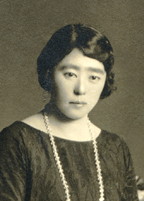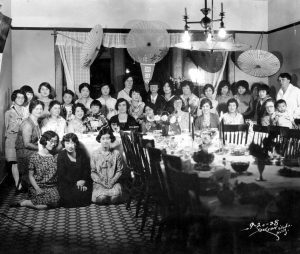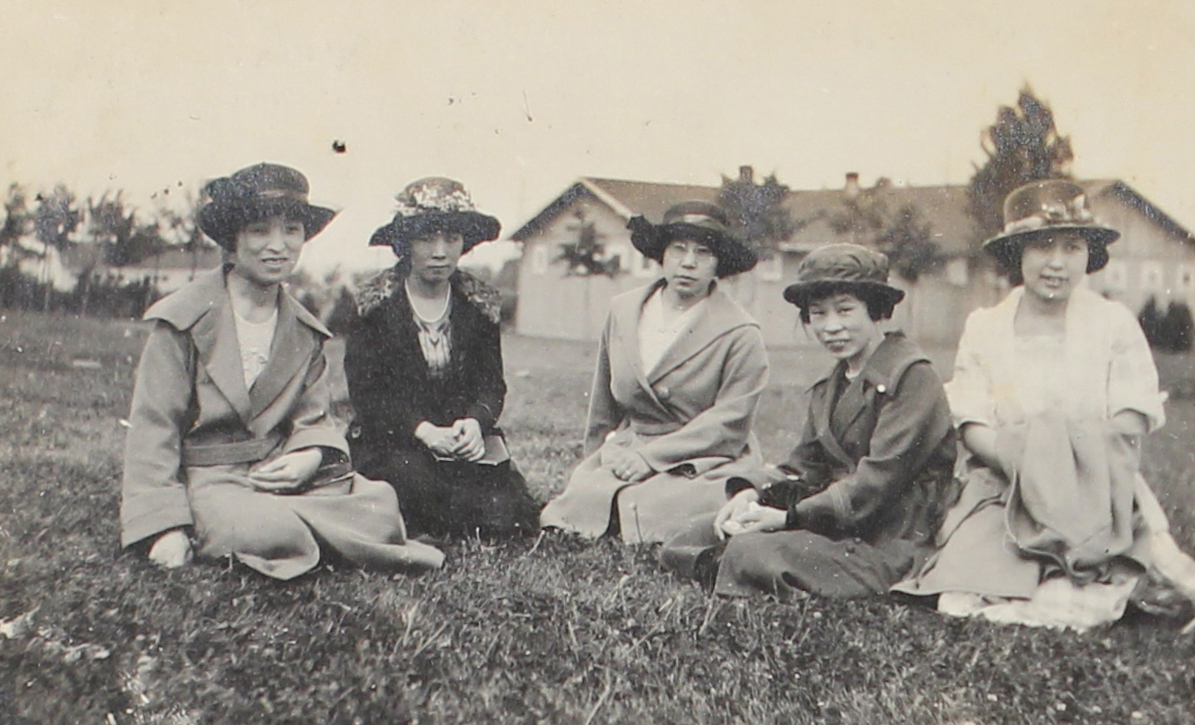March 21, 2017
1. YONA TSUDA ABIKO

Born into a former samurai family in 1880, Yonako Tsuda arrived in the United States in 1907. She met her future husband, Nichibei Shimbun publisher Kyutaro Abiko, during this year-long trip, and the couple married in Tokyo before returning to San Francisco in July 1909. Yona and other “ladies of status” established the Joshi Seinen Kai, a boarding house for Issei women where recent arrivals could learn the language and customs of their new home, in April 1912. The JSK eventually morphed into the Japanese YWCA. (Japanese Americans were only allowed limited participation in the official YWCA, and Yona’s crew was not here for that.) Under her leadership the organization shifted focus to the next generation, providing Nisei women with a place to practice sports, expand their education, and learn about their Japanese heritage. This last part was especially important to Yona, who was pushing Yellow Pride long before her Third World Lib descendants: Japanese culture was a gift, not a burden, and a powerful, they-go-low-we-go-high kind of middle finger to the daily grind of American racism.
After Kyutaro’s death in 1936, Yona became publisher of the Nichibei Shimbun and ran the paper like a capital-B Boss, weathering a fire that destroyed the Nichibei Building and a government-imposed suspension following Pearl Harbor. She was briefly incarcerated at Tanforan, but released within a week to continue cancer treatments and relocated to Philadelphia, where she died on March 4, 1944. But like a true badass, Yona continued to fight for Nikkei fam even in death. When the San Francisco YWCA tried to sell off the Japanese YWCA building in 1996—the property had been held in a legal trust that Yona helped create to get around California’s alien land law—it was her records that provided the evidence activists used to return the building to the Japanese American community.
2. ISHIKO SHIBUYA MORI
Ishiko was, as her son later put it, “born before her time.” Growing up in a prominent family of physicians in Chiba, her outspoken nature consistently got her in trouble with her parents, who sent her to live with a strict, matronly aunt in an attempt to subdue their daughter’s “unladylike” tendencies. Shortly after her father’s death, when she was 13, her family arranged a marriage with a 50 year old doctor—because forcing your teenage daughter into a dirty old man’s bed is a small price to pay for continuing the family bloodline. Unfortunately for them, Ishiko preferred her independence over submitting to the rapey whims of the patriarchy: if they wanted a doctor to continue the family profession, she would give them a doctor. She graduated from Tokyo Women’s College with a medical degree and, upon finding her male peers unwilling to degrade themselves by allowing an uppity woman to join their ranks, in 1927 immigrated to Hawai’i, where she worked at the Japanese Hospital in Honolulu.
She married fellow doctor Motokazu Mori and for a time focused on raising his two children from a previous marriage, and the two of her own that followed. But in 1934 she returned to work, this time as a special correspondent for the Yomiuri Shimbun. This position later put her in the crosshairs of the FBI: Just two days prior to the Pearl Harbor attack, Ishiko and Motokazu spoke to a Yomiuri political correspondent seeking information about military activity in Hawai’i. The conversation ended up being mostly about the flowers blooming in the Moris’ yard, but it was enough to get the intelligence agents creeping on the line worked up, and the couple was arrested on December 7, 1941. They were detained at Sand Island before being shipped to the mainland (on a freighter whose crew forced the internees to spend each night standing on the deck to discourage Japanese submarines from torpedoing “their own people”). In 1946, after nearly four years as camp doctors in Crystal City, Texas, they returned to Hawai’i. Ishiko went on to conduct research for the American Cancer Society and the University of Hawai’i, all the while continuing her journalism work and branching out into poetry. Get it, girl.
3. MITSU YASHIMA

Born Tomoe Sasako in Hiroshima Prefecture, 1908, Mitsu Yashima was a woman who knew how to get down for a cause. She entered art school in Tokyo in 1926 and quickly became part of a radical student activist community. She joined the Marxist, left-wing Proletarian Artists’ Union—the only female member, NBD—and lent her artistic and literary talents to protests against the increasingly repressive and militaristic Japanese government, colonial occupations in China and Korea, and abusive labor practices at home. After graduation Mitsu worked as a community organizer in Yamaguchi Prefecture, encouraging local women to join labor unions and fight the power. This political activism attracted attention, but not the good kind: she was jailed for nine months, sharing a six-foot square cell with a dozen other women, enduring regular beatings, and surviving off food scraps—all while pregnant with her first child. In 1939, Mitsu and her husband Taro (born Jun Atsushi Iwamatsu) left Japan to escape continued government persecution, leaving 5 year old Mako behind with his grandparents.
In 1941 Mitsu and Taro were eking out a living as art students in Manhattan. Not subject to incarceration on the East Coast, the couple instead worked for the Office of Strategic Services, changing their names to protect their son and other relatives from Kempeitai retribution. While Taro was on assignment in India, Mitsu became the “Voice of the People,” recording a radio propaganda program aimed at eroding Japanese support for the war. She gave birth to a daughter in 1948, and the following year Mako was finally able to join the rest of the family in the U.S. They moved to Los Angeles in the early 1950s and established the Yashima Art Institute and East West Studio, and co-wrote several successful children’s books. Mitsu divorced Taro in 1968 and moved to San Francisco, where she taught “people’s art” that uplifted the working class (as opposed to the fat cats at the top) at Japanese cultural centers and UC Berkeley—in addition to contributing to magazines and newsletters of the burgeoning Asian American Movement, and mentoring younger activists and artists. A revolutionary to the end, she remained active throughout her life, advocating for nuclear disarmament, criticizing the military occupation of Okinawa, marching in rallies, and even taking a 22-hour bus ride to join a Third World Women’s conference in Vancouver, BC at age 62.
4. TOME YASUTAKE

Tome Yasutake was part of a community of dedicated and hardworking sanba, or midwives, who catered to the Issei women of Seattle’s early Japanese American community. Born in Kumamoto in 1885, she left home to pursue a career in nursing mostly as a way to escape her evil stepmother. Tome proudly served as a Red Cross nurse in the Russo-Japanese War and graduated from the Kumamoto Nurse and Midwife Training School in 1908—overriding her brother’s objections that it was not an “appropriate” career for a woman. (Suck it, Nii-chan.) She married Mokuji Yasutake in 1909 and accompanied him back to Seattle, where he had been living for several years. The arranged marriage wasn’t exactly her top choice, but it gave her some much desired distance from Meiji Japan’s way strict gender roles and allowed her to see more of the world, an interest sparked by her time in Russia and Siberia.
One of Seattle’s earliest midwife practitioners, Tome devoted herself to the most vulnerable and at risk women in her community, often providing services free of charge and working with women other sanba would turn away, like non-Japanese mothers and women carrying children conceived—gasp!—out of wedlock. She also ran an unofficial rescue home for women leaving unhappy or abusive marriages. This practice of kakeochi, or wives deciding they’d had enough of their husbands’ shit, was frowned upon (to put it mildly). Issei newspapers frequently ran salacious accounts of slutty picture brides running off with younger, studlier men, not to mention creepy ads from husbands seeking the return of their property wives. Tome housed runaway brides in her own home until they could secure passage back to Japan or make other plans, in spite of her husband’s admonition that it was “none of her business.” In recognition of her 30-year legacy of midwifery and social work in Seattle and rural Western Washington, I leave you with this heavily paraphrased but feminist AF lesson she imparted to her daughters: Nobody owns your destiny but you, and don’t let any scrub tell you different.
—
By Nina Wallace, Densho Communications Coordinator
[Header photo: Five unidentified Issei women, likely in Seattle. Densho, courtesy of the Kyota Watanabe Collection.]

